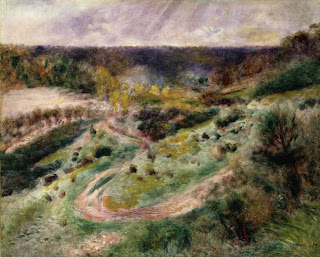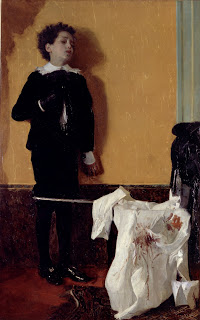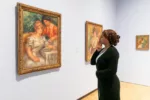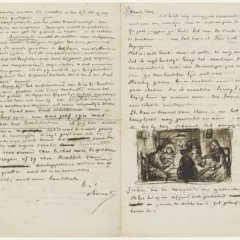I’ve previously expressed appreciation for exhibitions that reveal unknown or forgotten artists, or overlooked aspects of a well-known artist’s work. The Philadelphia Museum of Art has two such exhibitions at the moment: Renoir Landscapes and Antonio Mancini; Nineteenth-century Italian master

Renoir In the Woods ca. 1877, oil on canvas, 22″ x18 3/8″, The National Museum of Western Art, Tokyo, Matsukata Collection

More than Pretty Pictures of Plump Girls
I first came to a serious appreciation of Pierre-August Renoir as a landscapist a couple years ago in a previous exhibition at the PMA, Manet and the Sea. A painting of waves had brushwork so prominent and subject matter so recessive that it approached abstraction; it was no more conventional a landscape than one of Whistler’s Nocturnes. So I went to Renoir Landscapes with anticipation and was rewarded with a mixed group of works, the best of which made it well worth the visit.
The exhibition reveals an artist looking at his predecessors and contemporaries – Courbet, Corot, Monet, Cezanne – as he experiments in developing his own language with paint. He variously tries short stabbing strokes, quick suggestive outlines, paint trowled on with a palette-knife, luscious feathery brushwork, wet-into-wet paintwork, thick impasto and transparent glazes of color. His technique is rarely in the service of detailed physical description. It’s impossible to identify the materials depicted, such as the fabric of his women’s dresses; and he counter-intuitively uses the thickest paint to represent the insubstantial, such as the reflections of light on water.

Renoir Landscape at Wargemont 1879, oil on canvas, 31 3/4″ x 39 5/8″,Toledo Museum of Art
By 1877, with paintings such as In the Woods (National Museum of Western Art, Tokyo), Renoir abandons even the representation of space. The curators discuss the idea of pure landscape, meaning those with no figures or figures that are incidental. Renoir has gone further than that; this is pure painting, where only color differentiates form. Renoir incorporated more reds into his foliage than anyone before or since, and his thoroughly-polychrome palette and velvet-y brushwork make for very distinctive works. He was like the little girl in the nursery rhyme, with the curl in the middle of her forehead: when he was good, he was very, very good and when he was bad, he was horrid. When Renoir painted bad figurative works, they had awkward draughtsmanship and mushy compositions; when the landscapes are bad they aren’t horrid, but they’re insignificant. The exhibition gives an idea of this, but Into the Woods is one of a handful of great paintings in the exhibition, which includes The Gust of Wind (1872), Landscape at Wargemont (1879), The Wave (1879) and Wheatfield (1879).
The earliest works are in the first gallery and the latest in the last; but in between the PMA has chosen a thematic rather than chronological hang. Given the unimportance of the themes (Figures in the Landscape, Gardens, Cityscapes, …), I’d have preferred a chronological arrangement, as in the catalogue, which would have made it easier to follow the artist’s process. I’d also have preferred something less jarring than stark, white walls, which didn’t exist in the 19th century and don’t suit the work. This surprised me, since the PMA’s standard of installation is notably high.
And now, for something completely different

Antonio Mancini Self-Portrait with Basket c. 1883, pastel on paper, 27 1/8″ x 19 5/8″, Galleria Nazionale d’Arte Moderna e Contemporanea, Rome
Enthusiasts who learned about European art from the collections of major American museums could be forgiven for thinking that the Netherlands had no painters between Van Mieris and Mondrian, Germany none between Durer and Kirchner, no artists worked in Spain between Murillo and Picasso and Italian painting stopped with Tiepolo, not to be revived until the Futurists. Of course there were artists during each of these art historical black holes, but they’ve mostly been beyond the taste of collectors and museums kept what they had in deep storage. The PMA is currently filling one of these gaps. The museum was recently given a group of works by the largely-forgotten, Italian 19th century painter of Verismo (as realism was termed in Italy), Antonio Mancini, and has organized an international loan exhibition around them.

Antonio Mancini The Marquis Giorgio Capranica del Grillo 1889, oil on canvas, 81″ x 43″, National Gallery, London, Sir Hugh Lane Bequest (on loan to Hugh Lane Municipal Gallery of Modern Art, Dublin)
The man could paint – of his technical abilities there’s no question. John Singer Sargent was a fan of Mancini’s, but then Sargent was another technical virtuoso who only occasionally lived up to his promise. The portrait of Marquis Giorgio Capranica del Grillo demonstrates that Mancini could transcend conventional society portraiture and turn the genre into high art; but it’s the only portrait exhibited that reaches that level. The self-portraits are something else; it’s always interesting to see how an artist presents himself, and in Mancini’s case it’s a curiosity as well. In one pastel the artist bears an introspective expression and wears a basket, upside-down, as a hat. Mancini suffered from depression, for which he was hospitalized on one occasion, but I’m unwilling to credit this or the other well-executed works to his illness.

A number of the paintings show hackneyed subjects such as dream-y young women or sentimentalized children in curious costumes. The Statue Seller, a large painting of a recumbent, nude boy verges on kiddie-porn; a photograph of the same subject would likely attract police interest today. In the Boudoir, two buxom nudes disporting themselves amidst crumpled, gauze-y fabric surely crosses the line, arousing more erotic than artistic interest. Mancini is interesting in those works which betray an eerie psychological edge, such as After the Duel: a young boy in knee-britches and lace collar draws back from the sight of a dueling-sword and bloodied shirt prominent in the foreground. If that isn’t odd enough, he wears a black glove on only one hand.
The exhibition also includes objects and documents concerning the artist; most intriguing are two dinner plates on which the artist painted, supposedly when he couldn’t pay cash for meals. The exhibition is accompanied by a thorough and scholarly catalogue. Both contribute significantly to expanding our peripheral vision of 19th century European art, which the PMA has already broadened with its display of works by the likes of Joseph Franque, Léon Frédéric, Peter Severin Krøye and others.









